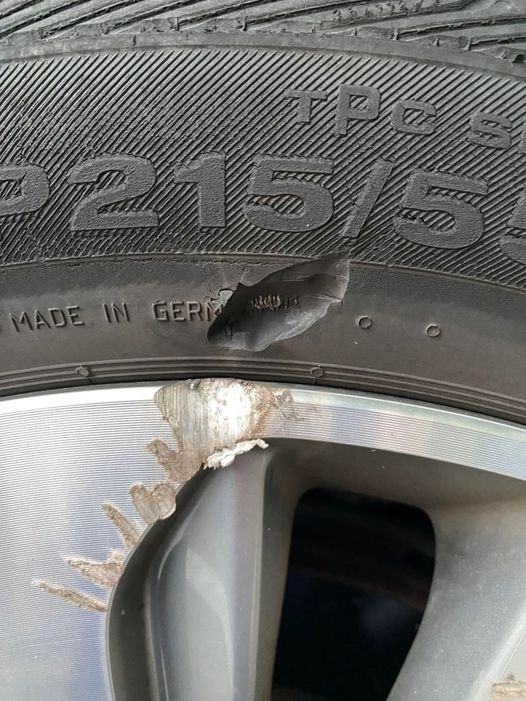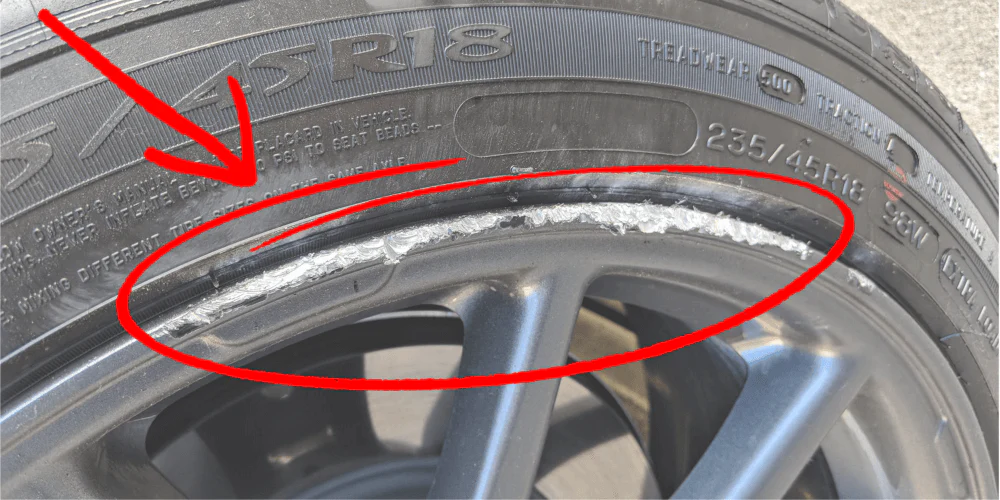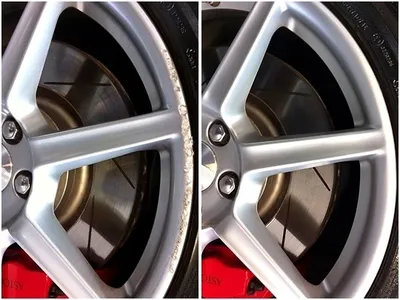So, you’ve just noticed some noticeable damage on your girlfriend’s car, specifically on the tire and rim. It looks like there’s a significant cut on the tire’s sidewall, and the rim appears to have suffered some curb rash. What could have caused these issues? Is it something to worry about, or can it be easily fixed? Before you jump to conclusions, let’s break down the potential reasons behind this kind of damage and what should be done about it. This guide will help you understand everything, from safety concerns to possible repair options.
Understanding Sidewall Damage: Why It’s a Major Safety Concern

When it comes to tire damage, the sidewall is one of the most vulnerable parts. Unlike the tire tread, which is reinforced to handle regular wear and tear, the sidewall is thinner and more prone to cuts, punctures, and cracks. In the image, the tear on the sidewall is quite concerning.
- What Causes Sidewall Damage? Sidewall cuts often occur when the tire scrapes against a sharp object, like a curb, metal debris, or pothole edges. This type of damage can also be caused by underinflated tires that flex too much while driving, making them more susceptible to cuts.
- Why It’s Dangerous: Sidewall damage is not just cosmetic; it can significantly affect the structural integrity of the tire. Unlike the tread area, the sidewall cannot be patched or repaired, as it handles much of the tire’s flexing and pressure. Driving with a cut sidewall increases the risk of a blowout, which can be extremely dangerous, especially at high speeds.
If you see a deep cut like the one shown in the image, the safest course of action is to replace the tire immediately.
What’s Causing the Curb Rash on the Rim?
The scratches and abrasions on the rim, commonly known as curb rash, are a frequent occurrence for many drivers. Curb rash usually happens when a car scrapes against the edge of a curb, often while parking or making a tight turn.
- Why Rims Get Damaged: Rims can easily get scratched when the tire’s sidewall makes contact with a hard surface. This can occur when parking too close to a curb or misjudging the turn radius when driving through narrow streets or tight spaces.
- Is It a Major Issue? While curb rash might not pose an immediate safety risk like sidewall damage, it can lead to other problems over time. Deep scratches on the rim can weaken the wheel’s structure and even affect the tire’s ability to maintain a proper seal, leading to air leaks.
If the damage is mostly cosmetic, it can be repaired by a professional, but if there’s significant gouging, replacing the rim may be necessary.
Immediate Steps to Take When You Spot Tire and Rim Damage
Finding tire and rim damage can be alarming, but there are some immediate steps you can take to ensure safety and address the issue effectively:
- Inspect the Tire Thoroughly: Carefully examine the extent of the sidewall damage. If the cut is deep enough to expose the internal structure (like cords or metal threads), do not drive the car any further. Call a towing service to have the vehicle safely transported to a tire shop.
- Check Tire Pressure: A cut on the sidewall can cause the tire to lose pressure rapidly. Use a tire pressure gauge to check if the tire is holding air properly. If the pressure is low, it’s best to inflate the tire temporarily (if possible) and drive slowly to the nearest service center.
- Examine the Rim’s Condition: Inspect the rim closely. If there are deep gouges or bends, the rim may be compromised and require professional assessment. Minor scratches, however, can often be repaired by a wheel repair specialist.
Why You Should Replace a Tire with Sidewall Damage
When a tire’s sidewall is compromised, it loses its ability to maintain pressure safely and could fail unexpectedly. Here’s why you should never ignore sidewall cuts:
- No Reliable Repairs: Unlike punctures on the tread, sidewall damage cannot be safely repaired. Sidewalls are not designed to handle patching or plugging, as the stress in this area of the tire is too high.
- High Risk of Blowouts: With the sidewall weakened, the tire is much more prone to a blowout—especially at highway speeds where pressure and heat build up rapidly. A blowout can lead to a loss of control, increasing the risk of an accident.
- Immediate Replacement Needed: For safety’s sake, a tire with a sidewall cut should be replaced as soon as possible. Driving on a damaged tire puts both the driver and passengers at risk.
Fixing Curb Rash: Repair or Replace the Rim?

Curb rash on rims is more of a cosmetic issue, but it can be fixed if it’s bothering you or affecting the wheel’s performance. Here are some repair options:
- DIY Repair Kits: For minor curb rash, you can find DIY repair kits that include sandpaper, filler, and paint to restore the rim’s appearance. While this won’t fix deep gouges, it’s an affordable solution for surface-level scratches.
- Professional Rim Repair: If the damage is more extensive, a professional repair service can usually restore the rim. They use techniques like sanding, buffing, and repainting to bring the rim back to its original condition.
- When to Replace the Rim: If the rim is bent, cracked, or has deep gouges, replacement may be the best option. Driving on a damaged rim can affect handling, cause vibrations, and even damage the new tire.
Could the Damage Indicate a Bigger Issue?
While tire and rim damage can happen to anyone, it’s worth considering if this damage is a sign of a bigger problem:
- Driving Habits: If this isn’t the first time you’ve noticed such damage, it might be worth discussing driving habits with your girlfriend. Often, repeated sidewall damage and curb rash indicate frequent encounters with curbs or potholes, suggesting a need for more cautious driving.
- Alignment and Suspension Issues: Frequent tire damage can also be a symptom of misaligned wheels or worn suspension components. It’s a good idea to have the vehicle checked by a professional to rule out underlying issues that could be causing the damage.
- Parking Locations: If the car is regularly parked in tight spaces or along busy streets, it increases the likelihood of rim and sidewall damage. Being more mindful about parking locations can help prevent future damage.

Conclusion: Prioritize Safety and Address Damage Promptly
Finding damage like sidewall cuts and curb rash on a car can be concerning, but it’s important to address it promptly to ensure safety. Sidewall damage poses a serious risk and requires immediate tire replacement, while curb rash can be fixed or left as-is if it’s purely cosmetic. Regardless, taking a closer look at the causes of such damage and adopting preventative measures can help avoid similar issues in the future.
If you’ve noticed these marks on your girlfriend’s car, having an open conversation about safety and repairs is crucial. Prioritizing tire and rim safety can make driving safer and more enjoyable, free from the worries of unexpected failures on the road.



